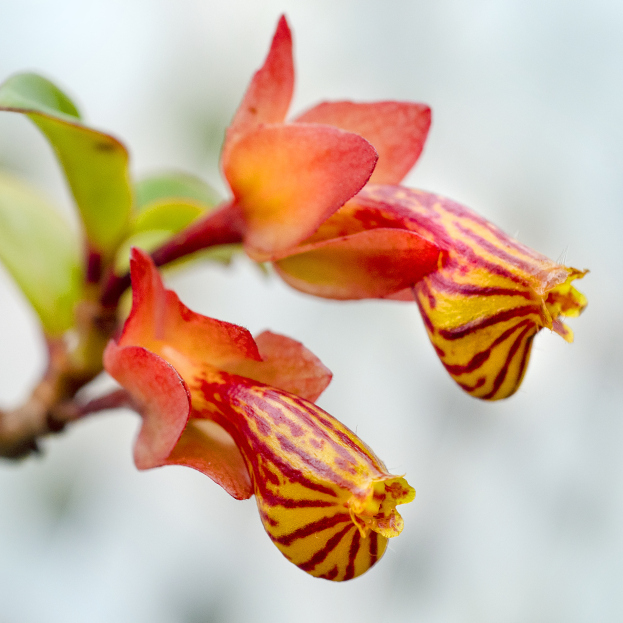
The Goldfish Plant (Nematanthus gregarius) is loved for its trailing vines, glossy green leaves, and vibrant orange blooms that resemble tiny goldfish! Native to Central and South America, this unique plant thrives indoors with a bit of tropical-inspired care. Here’s everything you need to know to keep your Goldfish Plant happy, healthy, and blooming.
Goldfish Plants are light lovers! They thrive in bright, indirect sunlight and need around 4-6 hours daily to produce their signature orange "fish" blooms. A spot near a sunny window with filtered light is ideal, like an east- or north-facing window. Too little light will prevent blooming and may lead to leggy growth, while too much direct sun can burn the leaves.
Tip: If natural light is limited, consider using a grow light to supplement light exposure, especially in winter months. When watering into a pot without drainage holes, be sure to discard any excess watering sitting at the bottom of your pot to prevent root rot or pests.
Goldfish Plants prefer consistently moist soil but dislike standing water. During the growing season (spring and summer), water your plant when the top inch of soil feels dry. Reduce watering in the fall and winter when the plant’s growth slows, but avoid letting the soil dry out completely.
Watering Tip: Goldfish Plants are sensitive to tap water chemicals, so using filtered or distilled water can help prevent leaf spots and other issues.
Being tropical, Goldfish Plants love high humidity and warm temperatures between 65-75°F (18-24°C). Try to keep humidity levels above 50%—misting the plant, placing it near a humidifier, or setting it on a pebble tray with water can help.
Avoid placing the plant near cold drafts, as sudden temperature drops can lead to leaf drop and slow growth.
Goldfish Plants need a well-draining potting mix to thrive. A peat-based mix with added perlite or orchid bark works well, allowing water to flow through easily while retaining enough moisture to keep the roots happy.
Goldfish Plants prefer to be slightly root-bound and don’t need frequent repotting. Repot every 2-3 years or when you notice roots emerging from the drainage holes. Choose a pot just one size larger and refresh the soil to give the plant a nutrient boost.
To propagate, select a healthy stem with at least two sets of leaves and use clean, sharp scissors or pruning shears to cut just below a leaf node. Remove any lower leaves from the cutting, leaving the top leaves intact. Dip the cut end of the stem in rooting hormone to encourage root development, and then plant the cutting in a well-draining potting mix, such as a mix designed for tropical plants. Keep the cutting in a warm, humid environment with indirect light to prevent it from drying out. Lightly water the cutting and maintain consistent moisture in the soil. After a few weeks, roots should develop, and the cutting will begin to establish itself as a new plant. Goldfish plants can also be propagated by dividing the root ball, but stem cuttings are the most common and easiest method.
Goldfish plants are considered non-toxic to pets, making them a safe option for homes with cats and dogs. They don't contain harmful chemicals or compounds that would pose a significant risk if ingested. However, while they are safe, pets may still be attracted to their unique, colorful flowers, and some animals may experience mild stomach upset if they chew on the plant. It’s always a good idea to keep any houseplants, including Goldfish plants, out of reach of curious pets to avoid unwanted nibbling.
Goldfish Plants are fairly heavy feeders and benefit from regular fertilization during their active growing season. Feed with a balanced, water-soluble fertilizer every 2-4 weeks from spring through early fall to support healthy growth and encourage blooming.
In the fall and winter, when growth naturally slows, reduce fertilizing to avoid nutrient buildup in the soil.
To keep your Goldfish Plant lush and full, prune any leggy growth by trimming back the stems. Pinching off old or dead flowers can help redirect the plant’s energy into producing new blooms and prevent it from looking scraggly.
Wipe the leaves occasionally with a damp cloth to remove dust and increase the plant's ability to absorb light, especially if it’s indoors.
Goldfish Plants naturally bloom from spring through fall, but it may take some time before they produce flowers, especially if they are young. To encourage blooms: